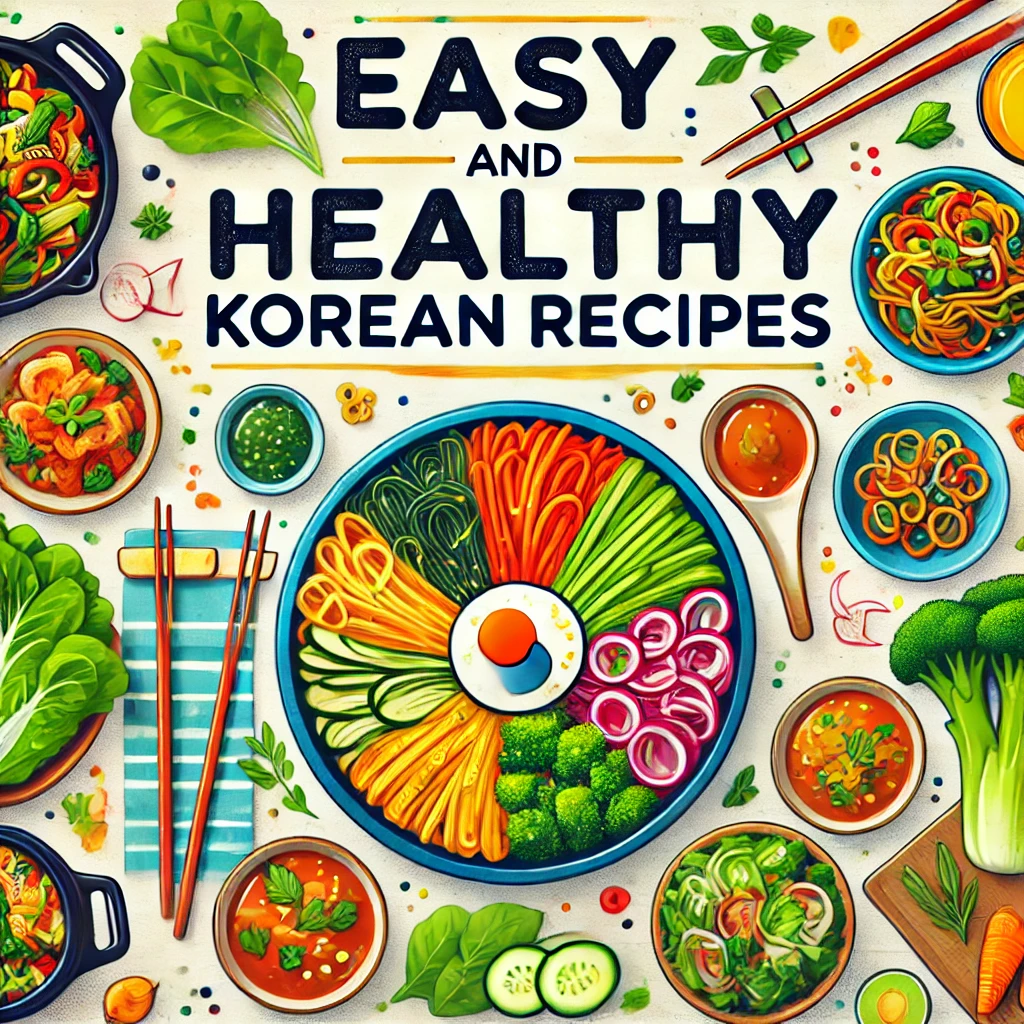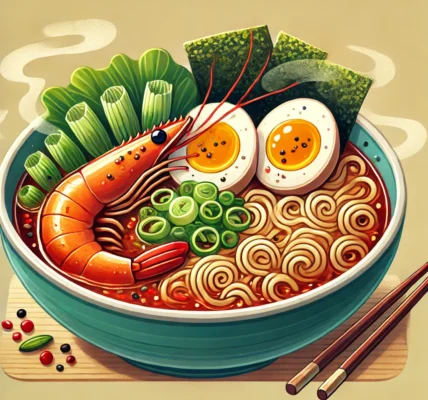Korean cuisine, known for its bold flavors and balance of nutrients, has gained global popularity for its unique taste and numerous health benefits. The beauty of Korean food lies in the combination of fresh vegetables, lean proteins, and flavorful fermented ingredients like kimchi. If you’re looking to make healthy, delicious, and authentic Korean dishes at home, this guide will introduce you to some simple yet satisfying recipes. Whether you’re new to Korean cooking or a seasoned pro, these healthy Korean recipes will be both accessible and enjoyable.
In this article, we’ll explore easy Korean recipes, step-by-step instructions, and nutritional insights. This content is SEO-optimized, with an emphasis on practical tips and detailed explanations to help you achieve the best results at home.

1. Bibimbap (Mixed Rice with Vegetables and Protein)
What Is Bibimbap?
Bibimbap is one of the most iconic Korean dishes and a perfect representation of Korean food’s balance of flavor and nutrition. It’s a mixed rice dish that combines a variety of sautéed vegetables, a protein source (often beef, chicken, or tofu), and a fried egg on top, served with gochujang (Korean red chili paste) for a spicy kick.
Ingredients
- 1 cup cooked white or brown rice
- 1/2 zucchini, julienned
- 1/2 carrot, julienned
- 1/2 cup spinach, blanched and seasoned with sesame oil
- 1/2 cup bean sprouts
- 4-5 shiitake mushrooms, sliced
- 1 egg (fried sunny-side up)
- 100g lean beef or tofu, sliced
- 1 tbsp sesame oil
- 1 tbsp soy sauce
- 1 clove garlic, minced
- 1 tbsp gochujang (Korean chili paste)
- Sesame seeds for garnish
Instructions
- Prepare the vegetables: Sauté zucchini, carrots, mushrooms, and bean sprouts individually in a pan with a bit of sesame oil and a pinch of salt.
- Cook the protein: Stir-fry the beef or tofu in a separate pan with soy sauce, minced garlic, and sesame oil.
- Fry the egg: Prepare the egg sunny-side up.
- Assemble: In a large bowl, place the rice at the bottom. Neatly arrange the vegetables and protein on top of the rice. Add the fried egg and garnish with sesame seeds.
- Serve: Serve with gochujang on the side. Mix everything together before eating.
Nutritional Insights
Bibimbap is packed with vitamins and minerals from the variety of vegetables. Using brown rice instead of white rice adds fiber, and tofu is a great protein option for vegetarians. Sesame oil provides healthy fats, while gochujang adds depth and a bit of spice without too many added calories.
SEO Tip:
- Keywords: Bibimbap recipe, healthy Korean food, mixed rice with vegetables
- Related Searches: How to make bibimbap, Korean mixed rice recipe
2. Samgyetang (Korean Ginseng Chicken Soup)
What Is Samgyetang?
Samgyetang is a traditional Korean soup made with whole chicken, stuffed with rice, ginseng, garlic, and jujubes (Korean dates). This dish is often enjoyed for its nourishing and restorative qualities, particularly in the summer as a way to replenish energy.
Ingredients
- 1 small whole chicken (about 1-1.5kg)
- 1/2 cup glutinous rice, soaked
- 4-5 garlic cloves
- 2-3 dried jujubes (Korean dates)
- 1 piece of ginseng root (optional)
- 2-3 green onions
- Salt and pepper to taste
- 6-8 cups water
Instructions
- Prepare the chicken: Clean the chicken inside and out. Stuff the chicken with soaked glutinous rice, garlic, and jujubes.
- Boil the soup: In a large pot, place the stuffed chicken and cover it with water. Add ginseng and green onions. Bring to a boil, then reduce to a simmer for about 1 hour.
- Season: Season the soup with salt and pepper. The chicken should be tender and fall off the bone.
- Serve: Serve the chicken whole, with a bowl of soup and rice on the side. Garnish with chopped green onions if desired.
Nutritional Insights
Samgyetang is low in fat, high in protein, and contains the added benefits of ginseng, which is known for boosting energy and improving circulation. The garlic in the soup offers immune-boosting properties, making this dish both comforting and nutritious.
SEO Tip:
- Keywords: Samgyetang recipe, Korean chicken soup, ginseng chicken soup
- Related Searches: How to make Samgyetang, Korean ginseng soup recipe
3. Kimchi Jjigae (Kimchi Stew)
What Is Kimchi Jjigae?
Kimchi Jjigae is a spicy Korean stew made with fermented kimchi, tofu, and pork or other protein. It’s a warming and hearty dish, perfect for colder months and a great way to use up older, fermented kimchi, which has a stronger flavor.
Ingredients
- 2 cups aged kimchi, cut into bite-sized pieces
- 100g pork belly, sliced (or tofu for a vegetarian option)
- 1/2 onion, sliced
- 1 block of tofu, cut into cubes
- 2 cups water or broth
- 1 tbsp gochugaru (Korean red pepper flakes)
- 1 tbsp soy sauce
- 1 tbsp sesame oil
- 1 tsp sugar (optional)
- 2 green onions, chopped
Instructions
- Sauté the pork: In a pot, heat sesame oil and sauté the pork belly until slightly browned. (For a vegetarian version, skip this step and add tofu later.)
- Add kimchi: Add the kimchi and cook for a few minutes until softened.
- Simmer the stew: Pour in water or broth, soy sauce, and gochugaru. Bring to a boil, then reduce to a simmer for 20 minutes.
- Add tofu: Gently add tofu cubes and continue simmering for another 10 minutes.
- Serve: Garnish with chopped green onions and serve hot with steamed rice.
Nutritional Insights
Kimchi Jjigae is rich in probiotics from fermented kimchi, which is great for gut health. The dish is low in calories but provides a satisfying, bold flavor. Tofu adds plant-based protein, making it a filling and nutritious meal.
SEO Tip:
- Keywords: Kimchi Jjigae recipe, Korean kimchi stew, healthy Korean stew
- Related Searches: How to make kimchi stew, Korean spicy stew recipe
4. Japchae (Stir-fried Glass Noodles)
What Is Japchae?
Japchae is a popular Korean side dish or main dish made with sweet potato glass noodles stir-fried with various vegetables and beef (optional), seasoned with soy sauce and sesame oil. It’s a colorful and flavorful dish that’s both light and filling.
Ingredients
- 200g sweet potato glass noodles
- 1/2 carrot, julienned
- 1/2 red bell pepper, julienned
- 1 onion, sliced thinly
- 1/2 bunch spinach, blanched and squeezed dry
- 100g beef, thinly sliced (optional)
- 2 tbsp soy sauce
- 1 tbsp sesame oil
- 1 tsp sugar
- 1 clove garlic, minced
- Sesame seeds for garnish
Instructions
- Cook the noodles: Cook the sweet potato noodles according to package instructions. Rinse under cold water and drain.
- Sauté vegetables and beef: In a large pan, heat sesame oil and sauté the carrots, bell pepper, and onions. Add the beef (if using) and cook until browned.
- Mix the noodles: Add the cooked noodles, soy sauce, sugar, and garlic to the pan. Toss everything together until well mixed.
- Add spinach: Stir in the blanched spinach and cook for another 2 minutes.
- Serve: Garnish with sesame seeds and serve as a side dish or main course.
Nutritional Insights
Japchae is a balanced dish rich in carbohydrates from the glass noodles and a variety of vitamins and minerals from the vegetables. It’s also gluten-free if you use tamari instead of soy sauce.
SEO Tip:
- Keywords: Japchae recipe, healthy Korean noodles, stir-fried glass noodles
- Related Searches: How to make Japchae, Korean glass noodles recipe
5. Doenjang Jjigae (Soybean Paste Stew)
What Is Doenjang Jjigae?
Doenjang Jjigae is a savory and hearty stew made with doenjang (Korean soybean paste), vegetables, tofu, and sometimes seafood or beef. It’s a staple in many Korean households and is both comforting and nutritious.
Ingredients
- 2 tbsp doenjang (Korean soybean paste)
- 1 zucchini, sliced
- 1/2 onion, sliced
- 1 block of tofu, cubed
- 1 potato, peeled and diced
- 4-5 shiitake mushrooms, sliced
- 1 clove garlic, minced
- 2-3 cups water or broth
- 1 green chili (optional for spice)
- 1 tbsp sesame oil
- Green onions for garnish
Instructions
- Boil the broth: In a pot, bring water or broth to a boil. Stir in the doenjang until it’s dissolved.
- Add vegetables: Add the zucchini, potatoes, onions, mushrooms, and garlic. Let simmer for 10 minutes until vegetables are tender.
- Add tofu: Gently stir in the tofu and continue simmering for another 5 minutes.
- Serve: Garnish with green onions and serve with steamed rice.
Nutritional Insights
Doenjang is rich in protein and probiotics, which aid in digestion and improve gut health. The tofu adds more protein, making this stew both nourishing and filling without being heavy in calories.
SEO Tip:
- Keywords: Doenjang Jjigae recipe, Korean soybean stew, healthy Korean soup
- Related Searches: How to make Doenjang Jjigae, Korean tofu stew recipe
Conclusion: The Health Benefits of Korean Cuisine
Korean cuisine emphasizes fresh vegetables, fermented foods, and lean proteins, making it one of the healthiest diets in the world. Whether you’re preparing bibimbap, samgyetang, or a comforting kimchi jjigae, these dishes are full of flavor and packed with nutrients. Incorporating these easy Korean recipes into your weekly meals not only introduces exciting flavors but also promotes a balanced and healthy lifestyle.
By focusing on wholesome ingredients and mindful cooking techniques, you can enjoy the benefits of Korean food right in your home.
SEO Tip Recap:
- Main Keywords: Healthy Korean recipes, easy Korean cooking, Korean food at home
- Related Searches: How to cook Korean food, healthy Korean meal ideas, simple Korean dishes
With these simple and healthy Korean recipes, you can bring the best of Korean cuisine into your kitchen, ensuring that every meal is both nourishing and delicious!













